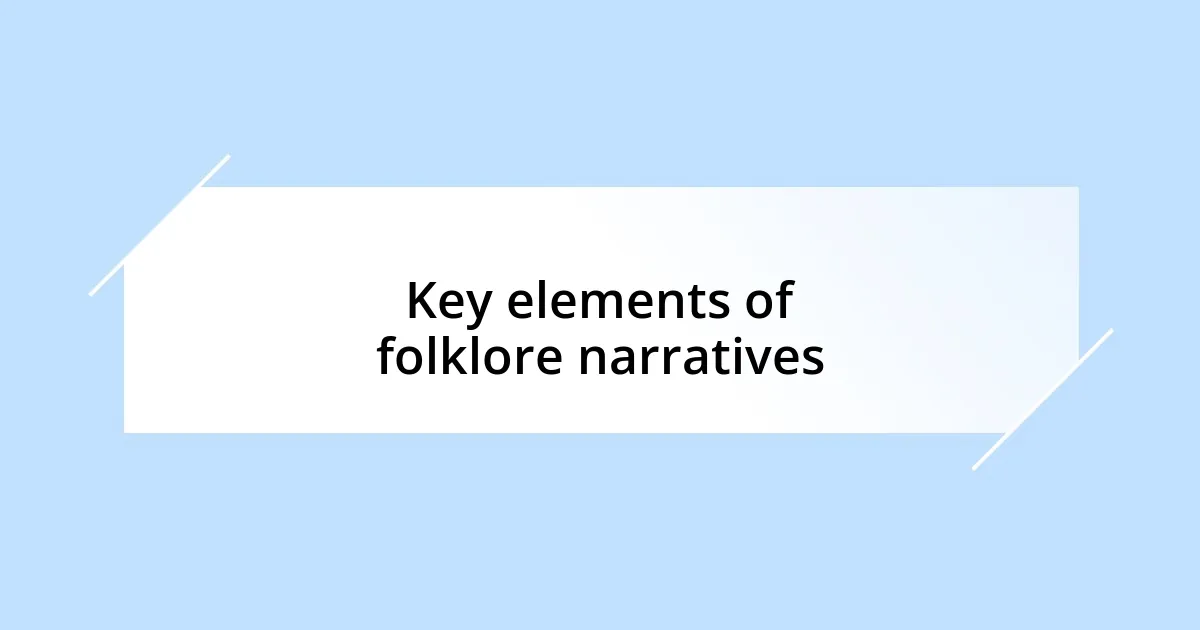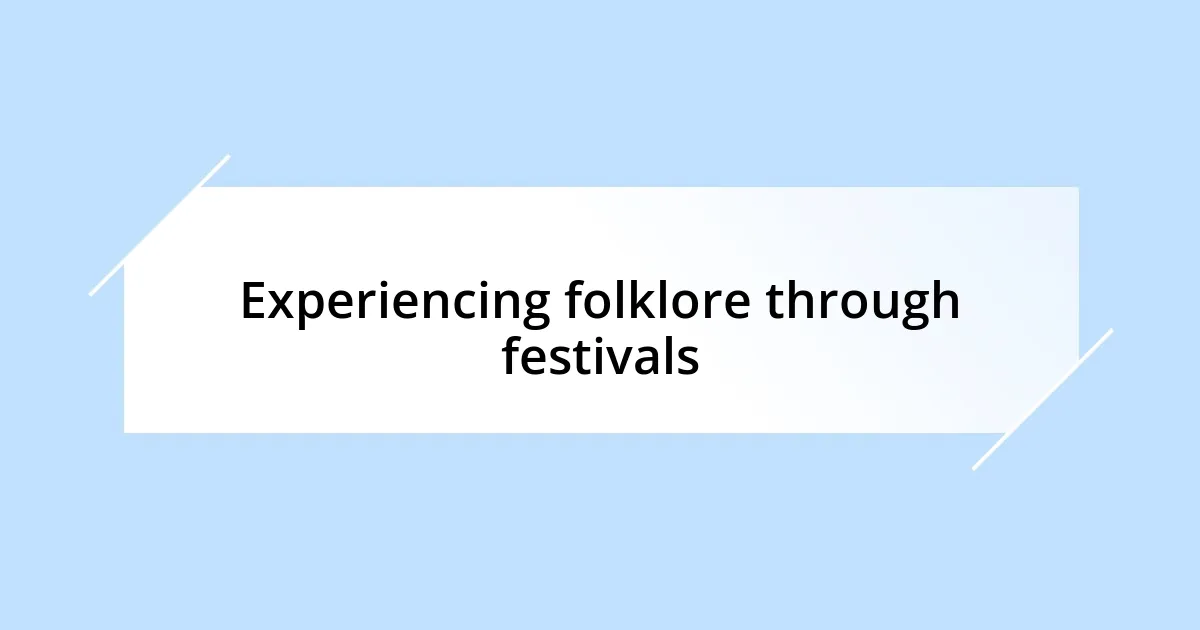Key takeaways:
- The author’s fascination with folklore began at a young age, sparked by stories shared by their grandmother, highlighting the connection between narrative and cultural identity.
- Traveling to various countries revealed the diversity and commonality in folklore, showcasing how stories reflect cultural values while fostering community and belonging.
- Key elements of folklore include archetypal characters, cultural wisdom, and magical realism, which enhance the storytelling experience and connect people universally.
- Preserving folklore is essential for maintaining cultural heritage, and modern technology plays a critical role in sharing and documenting these narratives for future generations.

My initial interest in folklore
When I think back to my initial interest in folklore, a vivid memory comes to mind. I was around eight years old, sprawled on the living room floor, engrossed in a book about mythical creatures from different cultures. There was something magical about the way these stories transported me to different worlds. It sparked a question in my young mind: how is it possible for people across the globe to have such similar tales?
As I delved deeper, I felt an undeniable connection to the stories of my own heritage. I remember sitting with my grandmother, listening intently as she recounted tales of legendary heroes and ancient spirits from our hometown. Her eyes would light up with each word, making me wonder—how do these stories shape who we are as a community? That sense of belonging and understanding became the foundation of my fascination with folklore.
Over time, I found myself drawn not just to the stories but to the wisdom behind them. What lessons were hidden in these age-old narratives? I began collecting tales, both spoken and written, with a yearning to understand the cultural underpinnings and the emotions that shaped them. This journey was not just about tales themselves; it was about exploring human experience through the lens of folklore.

Exploring different folklore traditions
Exploring different folklore traditions opened my eyes to the rich tapestry of human experience. I recall my travels to various countries, where I eagerly sought out local stories told by elders in bustling markets or serene village gatherings. Each narrative revealed a unique worldview and often reflected the values cherished by that community. It was fascinating to notice how folklore acts as a lens through which cultural identity is expressed.
In my experience, the similarities and differences among folklore traditions highlight a shared humanity while also honoring diversity. For instance, I was captivated by the way the Native American legends echoed themes of harmony with nature, while the Celtic tales often celebrated the supernatural. These nuances spurred delightful conversations with locals, where I learned the importance of storytelling in preserving culture across generations.
To better illustrate these contrasting themes, I created a quick comparison of folklore elements I encountered in my journey. It’s intriguing how these stories shape our understanding of the world and connect us across seemingly disparate cultures.
| Folklore Tradition | Key Themes |
|---|---|
| Native American | Harmony with Nature |
| Celtic | Supernatural |
| Japanese | Respect for Ancestors |
| African | Community and Family |

Key elements of folklore narratives
I’ve always been struck by the elements that give folklore its depth and resonance. One aspect that stands out to me is the use of archetypes. These characters—like the wise old man, the trickster, or the innocent hero—create a sense of familiarity. They embody universal traits we can all relate to. For example, when I first read the tale of Anansi, the spider from African folklore, I felt an instant connection. His cleverness and ability to overcome trials reminded me of my own struggles and triumphs.
Key elements of folklore narratives include:
- Archetypal Characters: These serve as familiar figures, helping convey messages or moral lessons.
- Cultural Wisdom: Each story often embeds knowledge specific to its culture, teaching values and norms.
- Magical Realism: The blending of the ordinary and extraordinary adds a sense of wonder and highlights human imagination.
Additionally, the setting plays a crucial role. Many tales are deeply rooted in specific landscapes, whether a dense forest or a bustling village. I recall sitting beneath a grand oak tree in my hometown, where my friends and I spun tales inspired by the natural world around us. It struck me how those landscapes didn’t just serve as backdrops; they informed the very essence of the stories, mirroring the experiences of those who lived there.

Experiencing folklore through festivals
Participating in festivals that celebrate folklore has been an exhilarating immersion into cultural expression for me. I vividly remember attending the Midsummer Festival in Scandinavia, where people gathered around bonfires, reveling in ancient rituals that promote the summer solstice. It felt like stepping back in time, as the lively music and traditional dances transported me, linking me to generations that celebrated the same way, reminding me of the joy of shared heritage.
At another festival, I found myself in a vibrant market during Día de los Muertos in Mexico, surrounded by colorful altars and the scent of marigolds. The stories shared about ancestors and their significance truly moved me. Each conversation illuminated the ongoing connection families maintain with their past, celebrating life and death through stories. It made me ponder—how do our own traditions echo through the stories we tell and the festivals we cherish?
I’ve noticed that these festivals not only honor traditions but also create a space for communal bonding. The sense of belonging is palpable when everyone partakes in the same songs and dances. I still remember the warmth of the community as we danced together under the stars during a folk festival in my own hometown. It impressed upon me that folklore festivals aren’t just about the past; they’re living memories that weave the community together, sparking connections that exist beyond time.

Collecting and preserving folklore
Collecting folklore is akin to holding a mirror to our heritage. I recall my own treasure hunt through old village archives and dusty libraries, where I stumbled upon handwritten stories that had been tucked away for decades. Each discovery felt like unearthing a piece of my identity; I could almost hear the voices of our ancestors whispering from the pages, sharing their joys and struggles. Have you ever felt that electric connection when reading old tales? It’s as if the past reaches out, eager to be remembered.
Preservation, on the other hand, requires intention and care. I’ve participated in community workshops aimed at recording local stories, and it’s heartwarming to see how participants light up when sharing their narratives. One elderly gentleman recounted his childhood adventures during wartime, his eyes glimmering with nostalgia and pain. Stories like his deserve to be captured, not just for history’s sake but for the emotional weight they carry. How do we ensure these timeless tales don’t vanish with time? Through audio recordings, written documentation, and, perhaps most importantly, sharing them with younger generations.
Digital platforms have also become vital in this journey of preservation. I remember the thrill of launching a local folklore blog, where I invited residents to contribute their family stories. Watching the community engage with this project reaffirmed my belief that preserving folklore isn’t just a solitary endeavor; it’s a collective effort. It prompts me to wonder—are we doing enough to nurture the curiosity in our youth? By intertwining past narratives with modern technology, we can create a tapestry of stories that reflect our diverse cultures.

Sharing my folklore experiences
During my journey, I’ve encountered folklore in the most unexpected moments. One afternoon, I found myself seated on a park bench in a small Slovak village, where an elderly woman began sharing tales of mythical creatures unique to the region. Her animated storytelling pulled me in, as she embodied these spirited beings with such passion that I almost believed they lived close by. Have you ever been so captivated by a story that it sparked your imagination? I realized then how personal folklore can be, bridging generational gaps, igniting wonder, and fostering connections through shared narratives.
One experience that stands out is when I participated in a local storytelling circle. As each person took their turn, I felt a wave of vulnerability wash over the group. One participant spoke about her grandmother’s struggles and triumphs during the war, turning personal grief into a collective experience. The emotional resonance was palpable; you could see tears in some eyes. This moment made me reflect—how often do we share our stories with others? By opening up in such spaces, we reveal the depth of our cultural fabric and highlight how folklore shapes our identities.
Through my experiences, I’ve also come to appreciate the deeper layers of folklore. I fondly recall visiting a small family-owned bakery in Sicily, known for its traditional recipes passed down through generations. As the owner recounted the origins of each pastry, I realized that each recipe was rooted in stories of love, hardship, and resilience. Isn’t it fascinating how food connects us to our heritage? This realization made me think about how sharing our folklore, whether through stories, songs, or culinary traditions, not only preserves the past but also enriches our present, binding us together in shared humanity.














